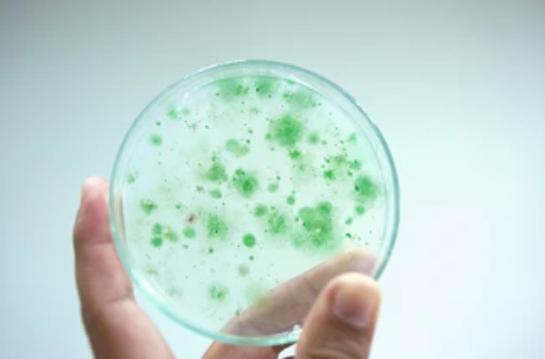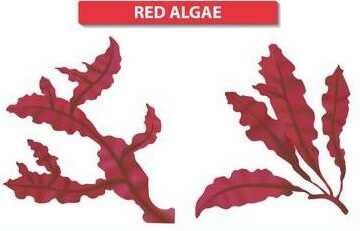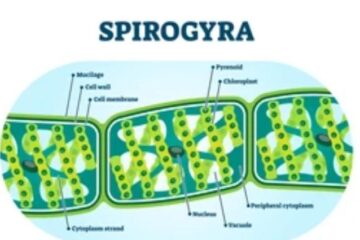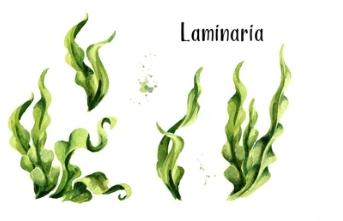Introduction
Green algae are a diverse group of photosynthetic organisms that belong to the kingdom Plantae. They are commonly found in various aquatic environments, including freshwater, saltwater, and moist terrestrial habitats. Green algae play a significant role in aquatic ecosystems as primary producers, using photosynthesis to convert sunlight into energy and producing oxygen as a byproduct.
These organisms come in various shapes and sizes, ranging from microscopic single-celled species to large, multicellular macroalgae. They can be unicellular, colonial, or filamentous, and some species form more complex structures like seaweeds. The characteristic green color of green algae comes from the presence of chlorophyll a and b, along with other pigments such as carotenoids and xanthophylls.
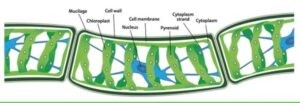
Green algae have a wide range of ecological importance. As primary producers, they form the foundation of food webs by providing sustenance to various herbivores and aquatic organisms. Additionally, some species of green algae serve as important indicators of water quality, as their abundance and health can reflect the overall environmental conditions of their habitat.
Beyond their ecological significance, green algae have also made significant contributions to scientific research. Studies on green algae have helped deepen our understanding of photosynthesis, cellular biology, and the evolutionary relationships between algae and higher plants.
While most green algae are harmless and beneficial, some species can be problematic. Some blooms of certain green algae can lead to harmful algal blooms (HABs), which can negatively impact aquatic ecosystems, human health, and local economies.
Overall, green algae play a crucial role in maintaining the balance of aquatic ecosystems, and their study continues to provide valuable insights into the workings of life on Earth. Researchers are also exploring their potential applications in biotechnology, biofuels, and other fields as we seek more sustainable solutions for various global challenges.
Definition
Green algae are photosynthetic microorganisms and some macroscopic species within the kingdom Plantae. They exhibit a green color due to chlorophyll and other pigments. Found in aquatic environments, they serve as primary producers, crucial for ecosystem balance, and are subjects of scientific research with potential applications.
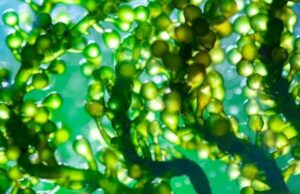
Characteristics
- Pigmentation: Green algae are named for their green color, which results from the presence of chlorophyll a and b, along with other pigments like carotenoids and xanthophylls. In contrast, other types of algae may have different pigment combinations, resulting in colors like red, brown, or golden-brown.
- Chloroplast Structure: Green algae have chloroplasts with a distinctive double-membrane structure, which is similar to the chloroplasts found in higher plants. Other algae may have different chloroplast structures, such as single-membrane chloroplasts in red algae or complex chloroplasts with multiple membranes in brown algae.
- Habitat: Green algae are found in a wide range of aquatic environments, including freshwater, saltwater, and moist terrestrial habitats. They can be free-floating, attached to surfaces, or form large seaweeds in marine environments. In contrast, other types of algae may have specific habitat preferences, such as red algae being commonly found in deeper marine waters and brown algae in intertidal zones.
- Cell Wall Composition: The cell walls of green algae contain cellulose, similar to higher plants. In contrast, other types of algae may have different cell wall compositions, such as red algae with cell walls containing sulfated polysaccharides.
- Reproductive Structures: Green algae exhibit diverse reproductive structures, including asexual reproduction through cell division and sexual reproduction involving specialized reproductive cells. The reproductive structures and strategies may differ in other types of algae.
- Evolutionary Relationships: Green algae are a diverse group with various evolutionary relationships to other algal groups and higher plants. While some green algae are considered to be more closely related to higher plants, others have more distant evolutionary connections to other algal lineages.

These differences highlight the unique characteristics and ecological roles of green algae within the broader context of algal diversity. Understanding these distinctions is essential for studying and appreciating the diversity and complexity of life in aquatic ecosystems.
Classification and taxonomy
The classification and taxonomy of green algae are as follows:
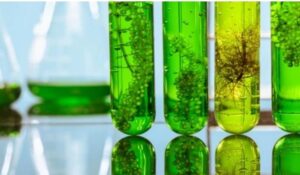
Kingdom: Plantae
Phylum: Chlorophyta
Classifications within the phylum Chlorophyta are based on various characteristics such as cell organization, pigments, and reproductive structures. As a diverse group, green algae include many different classes, some of which are:
- Chlorophyceae: This class comprises the largest and most diverse group of green algae. Members of Chlorophyceae can be unicellular, colonial, filamentous, or multicellular. They are commonly found in freshwater habitats, though some species can also be marine. Examples include Chlamydomonas, Volvox, and Spirogyra.
- Ulvophyceae: The members of this class are commonly known as sea lettuce or green seaweeds. They are multicellular macroalgae, and many are marine, though some inhabit freshwater environments. Ulva (sea lettuce) is a well-known example.
- Trebouxiophyceae: This class includes various unicellular and multicellular green algae, some of which are found in symbiotic relationships with other organisms like lichen-forming algae. Chlorella and Trebouxia are examples of this class.
- Charophyceae: This class is unique as it includes green algae that are most closely related to land plants (Embryophyta). Charophyceae share several key features with land plants, making them an essential group in understanding plant evolution.
- Prasinophyceae: This class consists of small, mostly marine, and sometimes unicellular green algae. They are believed to be one of the earliest diverging groups within the green algae lineage.
These are just a few examples of classes within the phylum Chlorophyta. Green algae exhibit considerable diversity, with many species yet to be discovered and classified. Taxonomists continue to refine and expand our understanding of green algae’s classification as new research provides insights into their evolutionary relationships and genetic diversity.
Morphology and diversity
The morphology and diversity of green algae are remarkably broad, encompassing various shapes, sizes, and structures. They can be found in diverse habitats, ranging from freshwater ponds and streams to oceans and even damp terrestrial environments. Some key aspects of their morphology and diversity are as follows:
- Cellular Organization: Green algae can exist as unicellular organisms, forming solitary cells or small colonies. They can also be filamentous, with cells arranged in chains or long filaments. Additionally, some green algae are colonial, where individual cells form a loose association, while others are multicellular macroalgae with specialized tissues.
- Cell Shape and Size: Unicellular green algae can exhibit various cell shapes, from spherical to oval or elongated. The size of green algal cells can range from microscopic (a few micrometers) to macroscopic (several centimeters) in multicellular forms.
- Chloroplasts: Green algae contain chloroplasts with chlorophyll a and b, which give them their characteristic green color. These chloroplasts are involved in photosynthesis, converting sunlight into energy.
- Reproductive Structures: Green algae can reproduce both asexually and sexually. Asexual reproduction involves methods like binary fission, fragmentation, and the formation of motile zoospores. Sexual reproduction involves the fusion of specialized gametes (isogamy, anisogamy, or oogamy).
- Habitat Diversity: Green algae have adapted to various environments, leading to a wide distribution. Some are predominantly found in freshwater bodies, including lakes, ponds, and rivers, while others thrive in marine ecosystems, such as seas and oceans. Additionally, some green algae can tolerate damp terrestrial conditions, growing on moist rocks, tree bark, or soil.
- Macroscopic Forms: Certain green algae are macroscopic and form large, multicellular structures known as seaweeds. These macroalgae can range from small and delicate to massive and complex, providing important habitats for various marine organisms.
- Microscopic Forms: Many green algae are microscopic, consisting of single cells or small colonies. Some species, such as Chlamydomonas, are unicellular flagellates that swim through water.
- Biochemical Diversity: Green algae exhibit a wide range of biochemical compositions and may produce various secondary metabolites, such as pigments, toxins, and compounds with potential pharmaceutical applications.
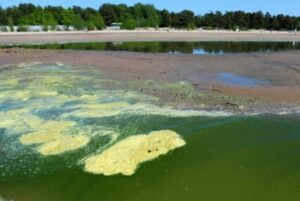
The vast diversity in the morphology and life cycles of green algae reflects their adaptive capabilities, allowing them to occupy diverse ecological niches. Their contributions to ecosystem functioning, their importance in food chains, and their potential applications in various fields make green algae a subject of significant scientific interest and exploration.
How photosynthesis is carried out in green algae?
Photosynthesis in green algae is a vital process through which these organisms convert light energy from the sun into chemical energy in the form of glucose. This process takes place in specialized cell organelles called chloroplasts, which contain the green pigment chlorophyll along with other pigments like carotenoids and xanthophylls. The general steps involved in photosynthesis are as follows:
- Light Absorption: Chlorophyll and other pigments in the chloroplasts absorb sunlight. The pigments absorb light in specific wavelengths, mainly in the red and blue regions of the electromagnetic spectrum, while reflecting green light, which gives green algae their characteristic color.
- Light Reaction: The absorbed light energy is used to initiate a series of chemical reactions known as the light-dependent reactions. During this phase, water molecules are split (photolysis) to release oxygen, and the energy from this process is used to generate adenosine triphosphate (ATP) and nicotinamide adenine dinucleotide phosphate (NADPH).
- Carbon Fixation: The ATP and NADPH generated in the light reaction are utilized in the light-independent reactions, also known as the Calvin cycle. In this phase, carbon dioxide (CO2) from the atmosphere is combined with a five-carbon compound called ribulose-1,5-bisphosphate (RuBP) to produce a three-carbon compound called 3-phosphoglycerate (3-PGA). This process is called carbon fixation.
- Reduction and Regeneration: The 3-PGA molecules are then reduced by ATP and NADPH to produce glyceraldehyde-3-phosphate (G3P), a three-carbon sugar. Some G3P molecules are used to regenerate RuBP, while others are used to synthesize glucose and other carbohydrates.
- Glucose Production: Multiple rounds of the Calvin cycle result in the production of glucose and other sugars. These carbohydrates serve as the primary source of energy and building blocks for the growth and development of green algae.
The overall equation for photosynthesis in green algae can be represented as:
6 CO2 + 6 H2O + light energy → C6H12O6 (glucose) + 6 O2
Photosynthesis not only sustains the life of green algae but also plays a crucial role in maintaining the balance of carbon dioxide and oxygen levels in aquatic environments. It is a fundamental process that supports the food web by providing energy for other organisms, making green algae essential primary producers in many ecosystems.
Ecological roles
Green algae play several important ecological roles in aquatic ecosystems:
- Primary Producers: Green algae are essential primary producers, meaning they are capable of converting sunlight into organic matter through photosynthesis. They use carbon dioxide and water to produce glucose and release oxygen as a byproduct. This process forms the foundation of the food web, providing energy and nutrients to other organisms in the ecosystem.
- Food Source: Green algae serve as a direct food source for many aquatic organisms, including zooplankton, small invertebrates, and some herbivorous fish. These primary consumers rely on green algae as a nutritious and readily available food supply.
- Habitat and Shelter: Macroscopic green algae, such as seaweeds, create complex habitats and provide shelter for a wide range of marine organisms. They offer protection from predators, a place to lay eggs, and a habitat for various invertebrates and small fish.
- Oxygen Production: During photosynthesis, green algae release oxygen into the water. This oxygen supports the respiration of aquatic organisms, ensuring their survival and contributing to the overall oxygen content in the ecosystem.
- Nutrient Cycling: Green algae play a role in nutrient cycling, taking up nutrients like nitrogen and phosphorus from the water and incorporating them into their tissues. When green algae are consumed by herbivores or decompose, these nutrients are released back into the ecosystem, supporting the growth of other organisms.
- Indicator Species: The abundance and health of green algae can serve as indicators of water quality. Changes in the population of green algae, especially the proliferation of harmful algal blooms (HABs), can signal imbalances in the ecosystem due to pollution or other environmental stressors.
- Carbon Sequestration: Green algae, like other photosynthetic organisms, remove carbon dioxide from the atmosphere during photosynthesis and store it in their tissues. As a result, they contribute to carbon sequestration and play a role in mitigating climate change.
- Erosion Control: In some coastal areas, macroscopic green algae, such as kelp, can help reduce shoreline erosion by absorbing wave energy and stabilizing sediments.
Overall, green algae play a critical role in maintaining the ecological balance of aquatic ecosystems. Their primary productivity, food web support, oxygen production, and habitat creation contribute to the overall health and diversity of marine and freshwater environments.
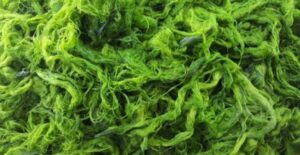
Habitat and distribution
Green algae are incredibly diverse and can be found in a wide range of habitats across the globe. Their distribution is closely linked to their adaptive capabilities and tolerance to various environmental conditions. Some common habitats and distribution patterns of green algae include:
- Freshwater Habitats: Green algae are abundant in freshwater ecosystems, such as lakes, ponds, rivers, and streams. They can thrive in both still and flowing waters, ranging from shallow to deep habitats. Examples of common freshwater green algae include species of Chlamydomonas, Spirogyra, and Zygnema.
- Marine Environments: Many green algae are found in marine habitats, particularly along coastlines and in intertidal zones. They can be seen in rock pools, tidepools, and attached to rocks or other substrates. Some marine green algae form large seaweed or kelp beds in deeper waters. Notable marine green algae include Ulva (sea lettuce), Enteromorpha, and Codium.
- Brackish Waters: Green algae can also adapt to brackish waters, which have a mixture of freshwater and saltwater. They are commonly found in estuaries, where rivers meet the sea, creating varying salinity levels. Some green algae can tolerate these fluctuations, making them well-suited to such environments.
- Terrestrial Habitats: While green algae are primarily aquatic organisms, certain species have adapted to terrestrial environments. They can be found in damp soils, on moist rocks, tree trunks, and in symbiotic relationships with lichens.
- Algal Mats: In certain shallow, nutrient-rich waters, green algae can form dense mats or blooms. These mats can cover large areas of water bodies and contribute to the ecological balance of these habitats.
- Ponds and Wetlands: Green algae are common in ponds and wetlands, where they contribute to the ecosystem’s nutrient cycling and primary productivity.
- Global Distribution: Green algae are distributed worldwide, from polar regions to tropical zones. Different species have adapted to specific temperature ranges and light conditions, allowing them to thrive in a wide variety of climatic conditions.
The distribution of green algae can be influenced by factors such as temperature, light availability, nutrient levels, water flow, and salinity. They have evolved to occupy diverse ecological niches, and their adaptability makes them important components of various aquatic and terrestrial ecosystems. Green algae’s role in primary productivity, nutrient cycling, and ecological balance highlights their ecological significance in the natural world.
Green alage and climate change
Green algae can both be affected by climate change and play a role in mitigating its effects. Here are some ways in which green algae and climate change are interconnected:
- Sensitivity to Temperature: Like other organisms, green algae are sensitive to changes in temperature. Increased water temperatures due to climate change can impact the growth, distribution, and reproductive patterns of green algae species.
- Altered Habitats: Climate change can lead to changes in precipitation patterns and increased frequency of extreme weather events, which can affect the availability and quality of habitats for green algae.
- Harmful Algal Blooms (HABs): Rising sea surface temperatures, together with increased nutrient runoff from human activities, can contribute to the occurrence and intensity of harmful algal blooms (HABs). These blooms can have adverse effects on marine ecosystems, including oxygen depletion and toxicity to marine life.
- Carbon Sequestration: Green algae, like other photosynthetic organisms, absorb carbon dioxide from the atmosphere during photosynthesis. As they grow, they store carbon in their tissues, contributing to carbon sequestration and helping to mitigate the effects of climate change.
- Biodiversity Impacts: Climate change can lead to shifts in species distributions and alter ecological interactions. This can have cascading effects on the biodiversity of green algae and the entire aquatic ecosystem.
- Ocean Acidification: Increased carbon dioxide concentrations in the atmosphere not only contribute to climate change but also lead to ocean acidification. As carbon dioxide dissolves in seawater, it forms carbonic acid, lowering the pH of the oceans. Ocean acidification can negatively impact green algae and other marine organisms that rely on calcium carbonate for shell formation and other essential processes.
- Potential Biofuel Source: Some species of green algae have attracted attention as a potential source of biofuels. Cultivating and using green algae for biofuel production could help reduce greenhouse gas emissions from fossil fuel use, contributing to climate change mitigation efforts.
To address the impacts of climate change on green algae and their ecosystems, it is essential to implement measures to reduce greenhouse gas emissions, enhance coastal and water quality management, and promote sustainable practices that protect marine and freshwater environments. Understanding the ecological responses of green algae to climate change is vital for devising effective conservation and mitigation strategies.
How do green algae contribute carbon sequestration?
Green algae contribute to carbon sequestration through the process of photosynthesis. During photosynthesis, green algae use carbon dioxide (CO2) from the atmosphere and combine it with water to produce glucose and oxygen. The glucose is used as an energy source for the algae, while the oxygen is released back into the environment.
The formula for photosynthesis is:
6 CO2 + 6 H2O + light energy → C6H12O6 (glucose) + 6 O2
The glucose produced during photosynthesis is stored in the algae’s cells as biomass. This biomass contains carbon derived from the carbon dioxide that was absorbed during photosynthesis. The carbon is effectively “captured” from the atmosphere and locked away in the algae’s tissues.
Over time, green algae can accumulate significant amounts of biomass, resulting in the sequestration of substantial quantities of carbon. Some green algae, especially macroalgae like kelp, can grow rapidly and form dense stands, further enhancing their carbon sequestration potential.
When green algae die or are consumed by other organisms, the carbon in their biomass may enter the marine food web or be deposited as organic matter on the ocean floor, effectively storing the carbon for longer periods. In this way, green algae contribute to the removal of carbon dioxide from the atmosphere, helping to mitigate the impacts of climate change.
Research is ongoing to explore the potential of utilizing green algae for carbon sequestration and biofuel production as part of broader efforts to develop sustainable solutions for climate change mitigation.
Harmful algal blooms
Harmful algal blooms (HABs) are excessive and rapid accumulations of certain species of algae in aquatic environments. While not all algal blooms are harmful, some can produce toxins or cause other negative impacts on the ecosystem, human health, and local economies. HABs are a global environmental concern and can occur in both freshwater and marine habitats. Here are some key points about harmful algal blooms:
- Causes: HABs are often triggered by a combination of environmental factors, including increased nutrient levels (eutrophication), warm water temperatures, calm water conditions, and sufficient sunlight. Human activities, such as agricultural runoff and sewage discharge, can contribute to elevated nutrient levels, fostering the growth of harmful algae.
- Toxin Production: Some species of algae in HABs produce potent toxins called harmful algal toxins (HATs). These toxins can have adverse effects on marine life, leading to fish kills, marine mammal mortalities, and harmful impacts on shellfish populations.
- Impact on Marine Life: The excessive growth of algae can lead to oxygen depletion in the water (hypoxia), as the decaying algae consume oxygen during decomposition. This can result in “dead zones” where marine life struggles to survive. Additionally, the toxins produced by HABs can harm marine organisms directly or indirectly through the food chain.
- Impact on Human Health: Harmful algal toxins can be transferred through the consumption of contaminated seafood, leading to a variety of health issues in humans, including gastrointestinal problems, neurological disorders, and even death in severe cases.
- Economic Consequences: HABs can have significant economic impacts on coastal communities. The closure of fisheries and shellfish harvesting areas due to contamination can result in financial losses for the fishing industry and associated businesses.
- Monitoring and Management: Monitoring programs are crucial for early detection and tracking of HABs. Authorities and environmental agencies use remote sensing, water sampling, and other methods to monitor algal populations and toxin levels. Efforts are made to manage nutrient inputs and prevent the occurrence of HABs.
- Climate Change Influence: Climate change can influence the frequency and intensity of HABs. Warming waters, altered ocean currents, and changes in weather patterns can create more favorable conditions for harmful algal growth.
To mitigate the harmful effects of algal blooms, proactive measures include implementing nutrient management strategies to reduce nutrient runoff, improving wastewater treatment, and developing early warning systems for HAB detection. Additionally, research continues to enhance our understanding of harmful algal species and their dynamics to develop effective management strategies.
Types
Green algae encompass a diverse group of organisms, and they can be classified into various types based on their characteristics and evolutionary relationships. Some of the common types of green algae include:
- Chlorophyceae: This is the largest and most diverse class of green algae, comprising many freshwater species. They can be unicellular, colonial, filamentous, or multicellular. Examples include Chlamydomonas, Volvox, and Spirogyra.
- Ulvophyceae: This class includes green algae commonly known as sea lettuce or green seaweeds. They are multicellular macroalgae and can be found in marine and some brackish water environments. Ulva (sea lettuce) is a well-known representative of this group.
- Trebouxiophyceae: Members of this class include both unicellular and multicellular green algae. Some species are symbiotic with other organisms like lichens. Chlorella and Trebouxia are examples of this class.
- Charophyceae: This class is of particular interest as it includes green algae that are most closely related to land plants (Embryophyta). Charophyceae share several key features with land plants, making them an important group in understanding plant evolution.
- Prasinophyceae: This class consists of small, mostly marine, and sometimes unicellular green algae. Some prasinophytes are believed to be among the earliest diverging groups within the green algae lineage.
- Desmids: Desmids are a specific group of green algae within the class Zygnematophyceae. They are known for their distinct cell shapes, which often appear symmetrical and resemble green gemstones under the microscope.
- Siphonous Green Algae: Some green algae, like Caulerpa, belong to the class Bryopsidophyceae and are unique for their siphonous growth form. They consist of a single giant multinucleate cell with multiple nuclei, giving them a distinctive appearance.
- Colonial Green Algae: Volvox, a genus within the class Chlorophyceae, is a well-known example of colonial green algae. They form spherical colonies, with each individual cell having its own flagella for coordinated movement.
These are just a few examples of the diverse types of green algae. There are many more species and groups within the green algae lineage, each with its own unique characteristics and ecological roles. Taxonomists continue to study and classify green algae as new research provides insights into their genetic diversity and evolutionary relationships.
Examples
Green algae comprise a vast and diverse group of organisms, and there are numerous examples of green algae species. Here are some well-known examples of green algae:
- Chlamydomonas reinhardtii: A unicellular green alga commonly used as a model organism in biological research, particularly in studies related to photosynthesis and flagellar motility.
- Volvox: A colonial green alga that forms spherical colonies consisting of thousands of individual cells. It exhibits collective movement through its coordinated flagella.
- Spirogyra: A filamentous green alga characterized by its spiral-shaped chloroplasts. It forms green, slimy masses in slow-moving freshwater habitats.
- Ulva (Sea Lettuce): A multicellular green alga commonly found in intertidal zones and shallow marine waters. It has a lettuce-like appearance and is edible.
- Chlorella: A genus of unicellular green algae that can be found in freshwater environments. Chlorella is used in various applications, including as a dietary supplement and for research purposes.
- Chara: A genus of charophycean green algae found in freshwater habitats. Chara species have a distinctive macroscopic appearance with a branching, plant-like structure.
- Enteromorpha: A green alga commonly found in marine environments, especially in shallow coastal areas. It forms bright green, sheet-like thalli.
- Caulerpa: A siphonous green alga found in marine environments, known for its unique growth form with a single giant multinucleate cell.
- Oedogonium: A filamentous green alga often found in freshwater habitats, particularly in slow-moving waters like ponds and ditches.
- Cladophora: A filamentous green alga found in marine, freshwater, and brackish water environments. It can form dense mats in water bodies.
These examples represent just a fraction of the vast diversity of green algae. The classification and understanding of green algae continue to evolve as researchers explore new species and study their ecological roles and biological characteristics.
How green algae reproduce?
Green algae reproduce through both asexual and sexual means, and the specific method can vary depending on the species and environmental conditions. Here’s an overview of how green algae reproduce:
Asexual Reproduction:
1.Binary Fission: Some unicellular green algae, like Chlamydomonas, reproduce asexually through binary fission. The cell divides into two daughter cells, each with a copy of the genetic material.
2.Fragmentation: Certain filamentous or colonial green algae can undergo fragmentation. The parent organism breaks into smaller fragments, and each fragment is capable of growing into a new individual.
3.Zoospores: Some green algae produce asexual reproductive cells called zoospores. These are flagellated cells that swim through water and eventually settle to develop into new individuals.
Sexual Reproduction:
Green algae employ various mechanisms for sexual reproduction, involving the fusion of specialized reproductive cells:
- Isogamy: Some species of green algae have isogamous sexual reproduction, where gametes (reproductive cells) from two different individuals are similar in size and shape. The fusion of isogametes results in the formation of a zygote.
- Anisogamy: In other green algae, sexual reproduction involves anisogamy, where two types of gametes are produced – one smaller and motile (male gamete) and the other larger and non-motile (female gamete). The male gamete fuses with the female gamete to form a zygote.
- Oogamy: Oogamy is a form of sexual reproduction found in more complex green algae, such as Ulva (sea lettuce). In oogamy, a large non-motile egg cell (ovum) is fertilized by a smaller motile sperm cell, resulting in a zygote.
After fertilization, the zygote undergoes mitotic divisions to develop into a new individual. The life cycle of green algae can be haploid-dominant (haplontic), diploid-dominant (diplontic), or display alternation of generations, depending on the species.
The ability to reproduce through both sexual and asexual means allows green algae to adapt to changing environmental conditions and maintain their population in various aquatic habitats. Their diverse reproductive strategies contribute to their ecological success and significance in aquatic ecosystems.
Conclusion
In conclusion, algae are a diverse group of photosynthetic organisms that play crucial roles in various ecosystems and have significant implications for human life. From microscopic unicellular species to macroscopic seaweeds, algae exhibit remarkable adaptability and serve as primary producers, supporting the foundation of aquatic food webs. Through photosynthesis, they convert sunlight and carbon dioxide into energy-rich compounds while releasing oxygen, contributing to the balance of atmospheric gases.
Algae also serve as habitat providers, creating shelter for a wide range of marine organisms and contributing to coastal ecosystem health. Their ability to remove excess nutrients from the environment helps in nutrient cycling and water quality maintenance. Furthermore, algae hold considerable economic importance, providing valuable resources such as food, pharmaceutical compounds, biofuels, and various industrial applications.
However, some algae species can lead to harmful algal blooms (HABs), producing toxins that negatively impact marine life, human health, and local economies. Understanding the factors influencing HAB formation and developing effective monitoring and management strategies are critical for mitigating their harmful effects.
As climate change continues to impact the planet, algae are affected by shifts in temperature, precipitation patterns, and ocean acidity. Nevertheless, green algae, in particular, contribute to carbon sequestration through photosynthesis, helping to mitigate the effects of climate change by storing carbon in their tissues and producing oxygen.
In conclusion, algae are fascinating and vital organisms that warrant ongoing scientific research and conservation efforts. Understanding their biology, ecology, and potential applications can lead to innovative solutions for sustainable practices, environmental protection, and human well-being in the face of global challenges.
Question and answers
Here are some questions and answers related to green algae:
Q1: What is green algae?
A1: Green algae are photosynthetic microorganisms and some macroscopic species within the kingdom Plantae. They exhibit a green color due to the presence of chlorophyll and other pigments.
Q2: Where are green algae commonly found?
A2: Green algae are found in a wide range of aquatic environments, including freshwater ponds, lakes, rivers, and marine habitats. Some species can also survive in damp terrestrial environments.
Q3: How do green algae reproduce?
A3: Green algae reproduce through both asexual and sexual means. Asexual reproduction includes binary fission, fragmentation, and the formation of motile zoospores. Sexual reproduction involves the fusion of specialized gametes.
Q4: What role do green algae play in the ecosystem?
A4: Green algae are essential primary producers in aquatic ecosystems, converting sunlight into energy through photosynthesis. They serve as a food source for various organisms, create habitats for marine life, and contribute to nutrient cycling.
Q5: How do green algae contribute to carbon sequestration?
A5: Green algae absorb carbon dioxide from the atmosphere during photosynthesis and convert it into glucose. The glucose is stored as biomass, effectively sequestering carbon from the atmosphere.
Q6: What are harmful algal blooms (HABs)?
A6: Harmful algal blooms (HABs) are excessive accumulations of certain algae that can produce toxins harmful to marine life and humans. They can lead to fish kills, oxygen depletion, and impacts on shellfish populations.
Q7: How can climate change affect green algae?
A7: Climate change can impact green algae through changes in temperature, precipitation patterns, and ocean acidity. Some species may experience shifts in distribution and reproductive patterns.
Q8: Can green algae be used for biofuel production?
A8: Yes, certain species of green algae are being studied for their potential use in biofuel production due to their rapid growth and high lipid content.
Q9: What is the ecological importance of green algae in marine ecosystems?
A9: Green algae provide food and habitat for many marine organisms, contribute to nutrient cycling, and support the overall health and diversity of marine ecosystems.
Q10: How can we prevent harmful algal blooms?
A10: Preventing harmful algal blooms involves reducing nutrient pollution, improving water quality management, and implementing early detection and monitoring systems.
Remember to explore further and seek more in-depth information on each topic to enhance your knowledge about green algae.

